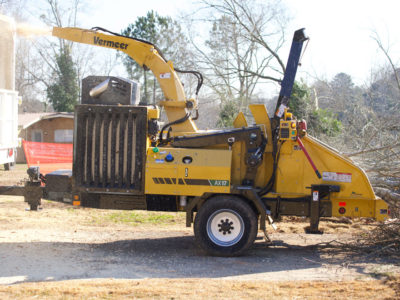When it’s time to invest in a new brush chipper, many tree care professionals ask themselves the question: Do we get one with a winch or go without? It’s a tough question to answer because on some jobs, having a winch to help pull material to the chipper can be a huge labor saver. However, on jobs where a loader or crane is being used, a winch can sometimes get in the way.
In many cases, the winch can be removed, but adding or removing the winch on most chippers takes a lot of time. It doesn’t have to be that way anymore. A patented winch boom that can flip up and out of the way when mechanically feeding the Vermeer AX17 brush chipper makes this machine unique in the market, providing you the versatility to bid winch- and machine-feeding applications with the same machine. With no boom hanging over the infeed, you can feed the brush chipper efficiently with a crane or loader with less labor.
The versatility provided by the flip-up boom allows the brush chipper to tackle almost any job. “It doesn’t limit you bidding select jobs,” said Cole Chesnut, application specialist for Vermeer Environmental Equipment. “The AX17 will perform in a variety of applications.”
When and when not to winch
A winch is a valuable tool when the material to be fed is difficult to access with a loading machine — such as when it is in a ditch, on a hillside or in a culvert — because it allows the material to be pulled clear of obstacles. The winch is also a valuable asset to feed the chipper when a loading machine is not available, such as on smaller jobs. It reduces the physical labor of getting material to the chipper. For example, the AX17 winch boom provides 3,200 pounds (1,451.5 kg) of pull-in force to help load large materials.
The downside of a winch with a fixed boom is it hampers machine feeding since you need to avoid contacting the winch boom with the grapple bucket. “You can still machine feed a brush chipper with a fixed winch boom, it’s just an obstacle that you must work around,” said Chesnut. The size of the machinery feeding the brush chipper and the size of the grapple bucket help determine how much of an obstacle the boom presents.
To make it more efficient to mechanically feed a brush chipper equipped with a winch, some customers remove the winch boom to get it out of the way. Removing a stationary winch boom from a brush chipper can be a tedious, time-consuming task. It requires the removal of several bolts and is a two-person operation due the weight of the winch, which can be hundreds of pounds. Refer to your machine’s operator’s manual for more information on winch removal. “Most people just take the winch boom off and then it stays off,” said Chesnut. “This dramatically lowers the power the winch can exert on the material and can make it a challenge to fully lift that material on the table.”
Efficient adjustments
The patented Vermeer AX17 brush chipper winch boom eliminates the tradeoffs associated with the stationary winch boom. The AX17 winch can lift the boom arm out of the way to allow unobstructed machine feeding. To perform this task, first remove the winch line loop from the winch interlock hook. “The rope loop can be secured to a cleat underneath the winch. A spring-loaded winch pin is then pulled, and the power of the winch is used to raise the boom up and out of the way,” said Chesnut. Release the winch pin once past the lowered locking position. This spring-loaded pin will lock into the raised position. “You will hear it click into place.” Refer to your machine’s operator’s manual for machine-specific information and safety messages. Now the machine is ready for machine feeding.
“To lower the boom back down to the lower position, which is required for transport, you release that spring-loaded pin. The winch boom will lower at a slow motion,” noted Chesnut. “Let the pin click into place. When the winch boom is stowed in the downward position, the winch rope should be secured to the winch interlock hook that keeps the line securely stowed when it is not needed.”
When the winch is needed, disengage the winch drum. This allows the tension on the winch line to be released and the loop to be removed from the interlock hook. The rope can then be pulled out. The winch can handle material up to 18 inches (46 cm) in diameter.
Stowing the brush chipper winch
It is important to properly stow the winch immediately after use and prior to continuing further chipping operations. With the feed rollers off, attach the winch rope to the interlock hook. Tighten the rope and pull the hook up. The winch will be locked out.
On the AX17, the winch engage/disengage lever must be fully locked into the engaged position to perform forward and reverse operation. If the lever does not lock into the engaged position, jog the retract/extend lever until it engages. When retracting the rope, maintain light tension to create smooth wrapping onto the winch drum.
Store any accessories, such as the choker, properly when not using the winch. Never permanently attach any chain or hook to the end of the winch line.
For more information about the Vermeer AX17, contact your local Vermeer dealer.
Vermeer Corporation reserves the right to make changes in engineering, design and specifications; add improvements; or discontinue manufacturing at any time without notice or obligation. Equipment shown is for illustrative purposes only and may display optional accessories or components specific to their global region. Please contact your local Vermeer dealer for more information on machine specifications.
Vermeer, the Vermeer logo and Equipped to Do More are trademarks of Vermeer Manufacturing Company in the U.S. and/or other countries.© 2022 Vermeer Corporation. All Rights Reserved.

